For most taekwondo federations and associations, Weapons Training is not a formal part of the curriculum. Many individual schools, however, will incorporate some weapons training into their syllabus. ATA Taekwondo schools, for example, often incorporate weapons training. As with unarmed taekwondo, weapons training in taekwondo usually incorporates a combination of techniques training along with forms training (see below).
Most of the weapons used in taekwondo are common to many styles of martial arts; they are not unique to taekwondo. In fact, many of them are more commonly seen in martial arts traditions from outside Korea. They have been adapted for taekwondo use by taekwondo schools and practitioners.
The list below is a small subset of the weapons used in martial arts; these are just the weapons most commonly seen in taekwondo. For a more complete list of weapons, see the Wikipedia article List of martial arts weapons.
Jahng Bong aka Bo Staff
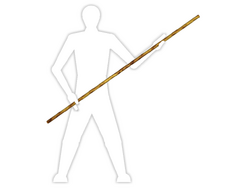
Jahn Bong, or Bo Staff
A bō (棒: ぼう) - bong (Korean term), kon (Chinese term), or kun (Okinawan dialect) - is a very tall and long staff weapon used in Okinawa and feudal Japan. Bō are typically around 1.8 m (5.9 ft) long and used in Japanese martial arts, in particular bōjutsu. Other staff-related weapons are the jō which is 1.2 m (47 in) long and the hanbō (half bō) (tahn bong in Korea, see below) which is 90 cm (35 in) long.
The basis of bō technique is te, or hand, techniques derived from Quanfa and other martial arts that reached Okinawa via trade and Chinese monks. Thrusting, swinging, and striking techniques often resemble empty-hand movements, following the philosophy that the bō is merely an "extension of one’s limbs". Consequently, bōjutsu is often incorporated into other styles of empty hand fighting, such as karate.
The bō is typically gripped in thirds, and when held horizontally in front, the right palm is facing away from the body and the left hand is facing the body, enabling the bō to rotate. The power is generated by the back hand pulling the bō, while the front hand is used for guidance. When striking, the wrist is twisted, as if turning the hand over when punching. Bō technique includes a wide variety of blocks, strikes, sweeps, and entrapments. The bō may even be used to sweep sand into an attacker’s eyes.
For more detail see Wikipedia.
Bahng Mahng Ee aka Eskrima Sticks
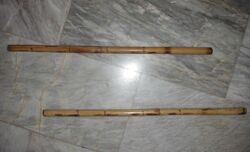
Bahng Mahng, or Eskrima Sticks
The Bahng Mahng Ee is a medium-length wooden stick, like a long baton. It can be practiced as a single weapon or used in pairs. The term eskrima is actually an umbrella term for a family of weapons used in Phillipino martial arts; eskrima sticks are just one member of that family. In the Phillipines, the stick is referred to as the yantok.
Sticks are typically constructed from rattan, an inexpensive stem from a type of Southeast Asian vine. Hard and durable yet lightweight, it shreds only under the worst abuse and will not splinter like wood, making it a safer training tool. This aspect makes it useful in defence against blades. Kamagong (ironwood or ebony) and bahi (heart of the palm) are sometimes used after being charred and hardened. These hardwoods are generally not used for sparring, however, as they are dense enough to cause serious injury, but traditional sparring does not include weapon-to-body contact. Practitioners are normally skilled enough to parry and counterstrike, showing respect in not intentionally hitting the training partner. In North America and Europe, eskrima practitioners wear head and hand protection while sparring with rattan sticks, or otherwise use padded batons. Some modern schools use sticks made out of aluminium or other metals, or modern high-impact plastics.
Read more about Eskrima at Wikipedia.
Dan Bong aka Short Stick
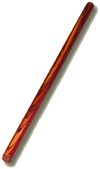
Dan Bong stick
The Dan Bong (also called Tahn Bong, or Short Stick) is a self-defense weapon measuring 8 to 12 inches in length and approximately 1 to 1.5 inches in diameter. The Dan Bong's use is in the application and reinforcement of joint lock, pressure point, choking, and striking techniques. The Dan Bong is commonly seen in Hapkido. The Dan Bong's small size allows for easy carrying and concealment from a potential attacker and an effective means of stealth armament. The Dan Bong can be used in short range attacks.
Read more about Dan Bong sticks in the Hapkido webpage on Wikipedia.
Sahm Dan Bong (삼단봉) aka 3-Section Staff
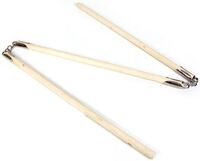
3-Section Staff
3-Section staff is one of the most difficult and versatile weapons practiced within martial arts. The three-section staff can be used as both a close-quarters weapon, a trapping weapon and as a long-range flexible whip-like weapon. Three-section staff was brought to Okinawa from Fujian Province by Shinko Matayoshi who incorporated it in Matayoshi Kobudo with two karate kata (sansetsukon dai ichi, sansetsukon dai ni) after 1935. The three-sectional staff, triple staff, three-part staff, sansetsukon in Japanese, or originally sanjiegun (Chinese: 三節棍; pinyin: sānjiégùn; Jyutping: saam1 zit3 gwan3), is a Chinese flail weapon that consists of three wooden or metal staffs connected by metal rings or rope. The weapon is also known as a "coiling dragon staff," or in Chinese as a "panlong gun" (蟠龍棍). A more complicated version of the two section staff, the staves can be spun to gather momentum resulting in a powerful strike, or their articulation can be used to strike over or around a shield or other defensive block.
Read more about the 3-Section Staff at Wikipedia.
Jee Pahng Ee aka Combat Cane
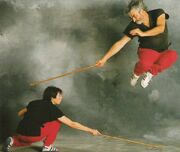
Maurice Sarry (right) practicing canne de combat.
Canne de combat is a French martial art. As weapon, it uses a cane or canne (a kind of walking-stick) designed for fighting. Canne de combat was standardized in the 1970s for sporting competition by Maurice Sarry. The canne is very light, made of chestnut wood and slightly tapered. A padded suit and a fencing mask are worn for protection.
When practiced as a martial art, the cane is a chestnut stick that comes in two versions: The first (marked with a green line) is heavier and used for training of basic techniques. Canne used in competitions and advanced training is lighter (marked with a black line). Lighter sticks are faster and safer to use (you can't seriously injure your opponent because the stick breaks first). The length of a canne is 95 cm, weight is ca. 120g for green and ca. 100g for the black canne.
Read more about the cane at Wikipedia.
Ssahng Jeol Bong aka Nunchuku
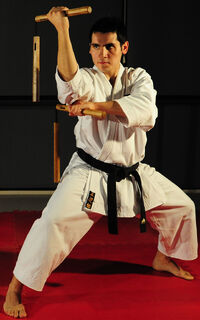
Nunchaku martial arts weapons displayed by Liechtenstein martial arts master Metin Kayar
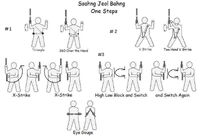
Example Ssahng Joel Bahng one-steps
The Ssahng Jeol Bong (aka Ssahng Joel Bong, or Nunchuku) is comprised of two short sticks connected by rope or chain. The Ssahng Joel Bong can be practiced as a single or double weapon and is admired for its speed and complex twirls; among martial arts weapons, it is a Hollywood cinema favorite. Consistent practice with the Ssahng Jeol Bong develops coordination and conditions muscles, especially the muscles of the arms and shoulders.
Some sources claim the Ssahng Jeol Bong once served the farmer in harvesting his crops by separating the grain from the shaft. The farmer would beat the crop with a tool that comprised of a long staff with a shorter stick attached to the end by a rope. During times of fighting or war, this farm tool could easily be used as a weapon. Some argue that this claim is a myth.
Often called a Chul Te or Dur Ree Ge, this weapons works very similarly to a mace. The length of the longer shaft allowed the warrior to stay at a safer distance from his opponent and would also aid in the generation of power in a strike. As peace time prevailed, the warriors, with little to do but train, fashioned the Cuhl Te into smaller versions creating the design we are familiar with today.
For more information, see Wikipedia.
Sai
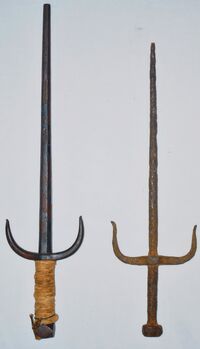
Two antique sai
The sai (釵) is a traditional weapon used in the Okinawan martial arts. The basic form of the weapon is that of a pointed, prong shaped metal baton, with two curved prongs called yoku projecting from the handle (tsuka). There are many types of sai with varying prongs for trapping and blocking.
In martial arts practice the sai is typically used in pairs, with one in each hand. Five kata (forms) are commonly taught, including two kihon (basic) kata. The style includes a variety of blocks, parries, strikes, and captures against attackers from all directions and height levels. Use of the point, knuckle and central bar is emphasized, as well as rapid grip changes for multiple strikes and blocks.
The utility of the sai as a weapon is reflected in its distinctive shape. It is primarily used as a striking weapon for short jabs into the solar plexus but it also has many defensive techniques.
Read more about Sai at Wikipedia.
Jitte
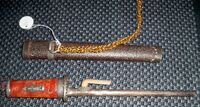
Jitte
- This section pertains to the weapon Jitte. For the taewkondo form of the same name, see Jit-te.
A jitte (十手, literally "ten hands") is a specialized weapon that was used by police in Edo period Japan. It is also spelled jutte.
In Edo period Japan the jitte was a substitute for a badge and represented someone on official business and was carried by all levels of police officers including high-ranking samurai police officials and low-rank samurai law enforcement officers (called okappiki or doshin). Other high-ranking samurai officials carried a jitte as a badge of office, including hotel, rice and grain inspectors (aratame). The jitte is the subject of the Japanese martial art of juttejutsu.
Read more about Jitte on Wikipedia
Sahang Naht aka Kama
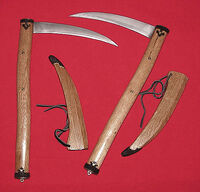
Kamas
The Sahang Naht (or Kama) are traditional farming implements similar to a sickle used for reaping crops and also employed as a weapon. Before being used in martial arts, the Sahang Knat was widely used to cut crops, mostly rice. The Sahang Naht is a formidable weapon, traditionally used in pairs, though in agricultural use it would be used one-handed As a weapon, both the point and sharpened edge of the metal blade are called in to use, while the Sahang Naht could also be used to block, trap and disarm weapons used against the wielder. The hard edge of the Sahang Naht blade would traditionally be kept razor-sharp to enable efficient cutting of crops, which made it a lethal weapon in the right hands, though this is sometimes a cause of training accidents by unskilled wielders, for whom blunt training versions of the weapon are created. It is also a popular modern forms competition weapon.
Read more about Kama at Wikipedia.
Spear
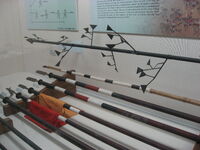
An assortment of Korean spears
Historically, spears have been commonly-used weapons throughout most of the world, including Korea. So while most of the weapons listed on this page do not have a long tradition of use in Korea, weapons such as the spear and the bow do.
Spears and pole-arms were utilized heavily throughout the history of Korean warfare with some types serving specialized purposes. Especially during the Three Kingdoms of Korea period, in which wars among the Korean states - as well as with neighboring Chinese dynasties - were highly frequent, Korean military forces were constantly improving upon weaponry and martial practices. During this time period, spears were often lengthy and sturdy and were armed by heavily armored shock infantrymen, reflecting the prevalence of cavalry engagements and open combat.
Read more about the spear, including the Korean tradition of spear use, on the general Wikipedia article Spear.
Gumdo Swords
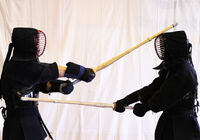
Gumdo practice with bamboo blades
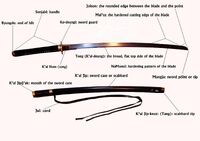
An edged Korean sword
Of course there are many types of swords; Gumdo (or Kumdo) is a Korean adaptation of the swords used in Japanese Kendo. Because Gumdo requires coordination more than athletic prowess, gumdo practice is often popular with older taekwondo students.
Gumdo is a modern Korean martial art. Though romanized in a number ways when written -- kǒmdo, gumdo, or geomdo - the meaning remains "the way of the sword" and is cognate with the Japanese term. As a martial art, Kumdo has become accepted in Korean culture and society since its introduction from Japan to the degree that the term "Kumdo" has, in recent history, become a generic label for other Korean martial arts based upon swordsmanship.
Read more:
Dan Gum aka Dagger
During the long history of the knife as a weapon, many systems or schools of knife fighting have developed around the world. Each is usually distinguished by region and culture of their origin. In past centuries the repeated invasion and conquest of foreign territories by invading armies frequently resulted in the dissemination and adoption of knives and knife fighting techniques. These were in turn adapted and improved upon through long practice and drills, sometimes over hundreds of years.
Knife fighting is emerging as a prominent component of various martial art styles and is quickly growing as a sport, known sometimes as knife fencing, where simulated knives, such as those made from rubber or "shock knives", which utilize a mild electroshock blade, are used to strike or slash scoring zones for points.
To read more about the use of knives in martial arts, see the Wikipedia article Knife fight.
Other Weapons of Note
Gungdo aka Bow
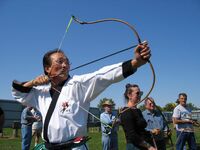
Korean bow
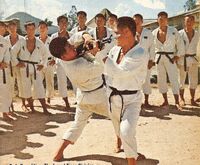
Arguably, bayonet was the original weapon of taekwondo. Here Korean soldiers train in bayonet at a military base in Vietnam in the 1960s.
Somewhat surprisingly, the bow is rarely taught in taekwondo; surprising in the sense that of all the weapons listed on this page, the spear, sword, and the bow are the three with the most distinctively Korean traditions. During the Mongul invasion of Korea in 1231 C.E., the Korean bow (Gungdo) turned out to be by-far the most effective weapon against the invading Mongul warriors. The bow had already had a central place in ancient Korean martial arts, but after the Mongul invasion it became preeminent among Korean weapons arts.
Read more about the Korean bow on Wikipedia.
Bayonet
Of course the bayonet is generally not taught in modern taekwondo, but it should be pointed out that when his version of taekwondo was first being developed for the South Korean military by General Choi Hong Hi, bayonet training was in fact a central part of the curriculum. In that sense, the bayonet could be said to be an important weapon within the taekwondo tradition. In fact, Bok Man Kim's taekwondo hybrid martial art - Chun Kuhn Do - still trains in bayonet even today.
Forms
The following forms are examples of forms sometimes used in taekwondo weapons training:
| Weapon | Forms |
|---|---|
| Jahng Bong (Bo Staff) |
Bong Hyung Il Bu |
| Bahng Mahng Ee (Eskrima Sticks) | |
| Dan Bong (Short Stick) |
Kwon Moo Gu, 50 steps |
| Sam Dam Gong (3-Section Staff) | |
| Jee Pahng Ee (Combat Cane) | |
| Ssahng Jeol Bong (Nunchuku) | |
| Sai | Sai Kata 1 |
| Jitte | |
| Sahn Knat (Kama) | Kho-Bu Ni-Cho Kama |
| Spear | |
| Gum (Sword) | |
| Dan Gum (Dagger) |
Dan Gum Hyung (Dagger Form) |
Example forms include:
- Silla 1, Silla 2
See Also
References
- This website discusses traditional Korean weapons: http://www.turtlepress.com/training/traditional-korean-weapons
- http://www.sungshilkwan.com/TangSooDo/Docs/Weapons_forms.pdf
- http://en.wikipedia.org/wiki/Weapons_of_Kuk_Sool_Won